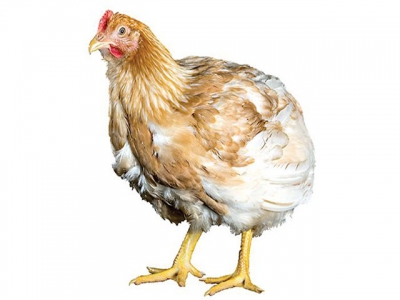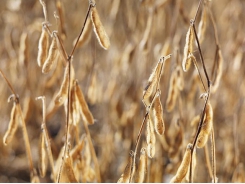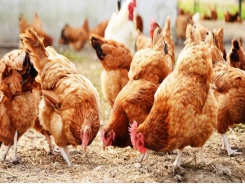10 slow-growing broiler feeding tips

The nutrient density and the raw materials of slow-growing broiler diets should be altered to ensure profitability. | Cobb-Vantress Inc.
Nutritional specifications, diet regimen, feed intake and growth rates all need careful consideration by producers moving into this sector.
Slow-growing broiler breeds, birds with different carcass conformation to fast-growing strains, are increasingly popular in poultry production. Slow-growing strains have less efficient feed conversion than conventional breeds and require more space per head. As such, costs increase by 25 to 30 percent or more.
Niche markets for slow-growing broilers have already been established in the U.K., France and the Netherlands, supported by accreditation schemes, which specify certain slow-growing breeds, growth parameters, management systems and the age to which they are kept.
To make production cost effective, as well as ensuring health and welfare of the birds, specific diets should be formulated.
Slow food trend
The growing market for slow-growing broilers has been driven by two main factors: first, animal welfare. There is a belief that birds that grow slower are happier and healthier. It is from this standpoint that animal rights groups, e.g. the Global Animal Partnership (GAP) in the U.S., are putting pressure on food retail and service companies to only buy slow-grown chicken.
The second is taste and quality, where consumers are happy to pay more for a premium product. This fits with the rest of the slow food movement, where the use of traditional breeds of animal or varieties of plants sits alongside less intensive production methods. Accreditation bodies include GAP (U.S.), Royal Society for the Prevention of Cruelty to Animals (RSPCA) assured (U.K.), Label Rouge (France) and Better Life in the Netherlands, where already slow-growing broilers make up 25 to 30 percent of production.
Slow-growing breeds
Broilers bred specifically for the organic and free-range chicken markets have been available for some time. These are brown or colored birds, suited to a more traditional style of production. While fast-growing broilers do not perform as well in free-range systems, these rustic birds perform equally outside and in. In some cases, the male and female parent stock are brown while, for others, a brown female is crossed with a standard white male broiler. In this case, the growth rates and carcass conformation are intermediate.
As standard commercial breeds have gotten heavier, the breast meat yield has increased (~30 percent) — fitting with the demand for white meat. Older style breeds have a very different carcass confirmation, with 10 percent less breast meat but larger legs and wings.

Compared with modern commercial breeds, slower-growing breeds have lower carcass and breast meat yields. | Tatijana Fisher, University of Kentucky
Broiler performance objectives
In standard commercial broiler production, birds are grown for about 39 days, dependent on their destined end product. However, slower-growing birds are kept for significantly longer:
- Indoor: More than 49 days
- Free range: More than 56 days
- Organic: More than 70 days
The exact production period will be dependent on any accreditation scheme producers are part of, as well as the market into which they will be sold.
In several of the breed manuals, different growth rates are quoted: first, that of the bird’s true genetic potential and, second, for the daily gain prescribed by certain certified programs.

In week 6, there is more than a 50 percent difference in the growth rates of fast- and slow-growing broiler breeds. | Aviagen
Along with management guidelines, minimum age of slaughter and maximum daily growth rates are required for accreditation. For example, GAP suggests a growth rate of less than 50 grams a day, significantly lower (23 percent) than the industry average of 61 grams per day. Comparison of the (as hatched) growth rates of three commercial breeds — fast, fast-slow cross and a pure slow-growing breed — shows that there may be a greater difference between male and female slower-growing breeds, leading to recommendations for some to be reared separately and fed a differently specified diet.
broiler-breed-nutrient-recommendations
Feed intakes, growth rates and growing period all need to be considered when formulating diets for slow-growing broilers. | Cobb-Vantress Inc.
Slow-growing broiler nutrition
Industry-recommended feed formulas for a fast and slow-growing broiler breed vary; however, as they eat less feed each day, overall intake will be lower. Based on research and expert thinking, the following list provides some points to consider:
- Energy: Levels in the diets can be slightly lower but, as feed intakes are less, it can’t be reduced too much — a certain amount of energy is required.
- Protein and amino acids: Trials have shown that levels can be lowered, without affecting performance.
- Alternative raw materials: Using ingredients with higher fiber levels or less digestible co-products could offset the increased feed costs of slow-growing broilers.
- Macro minerals: As birds will be longer on their legs, it is essential to support skeletal development and bone mineralization. However, studies show improved gait score and less lameness in slower-growing birds. This is thought to be due to the combination of body conformation (smaller breast, larger legs) and slower growth rates.
- Vitamin and mineral premixes: Breed companies aren’t suggesting any significant differences in the levels needed in diets for fast- and slow-growing broilers. However, the amount they will consume will be in line with a lower feed intake, although the volume over the whole period will be greater.
- Antibiotic free (ABF): Reducing the use of antibiotics is a target for many producers but an ABF claim often sits alongside a slow-grown broiler label. As such, supporting gut health and bird immunity should be a focus in terms of additive addition, diet specifications and ingredient selection.
- No need for a super- or pre-starter diet: The starter diet will generally be fed for nearly three times as long and the birds will consume four times the amount of it. While it is important to get birds off to a good start, a short nutrient boost isn’t required in a diet fed for about one-third of its life.
- Number of diets: Most breed companies still specify three diets: starter, grower and finisher. However, each will be fed for much longer and cover a larger growth range. The grower ration will be fed for twice as long and the finisher from 40 days until slaughter — potentially more than 30 days later.
- Consult accreditation schemes: As mentioned, many insist on no growth promoter, while others have minimum cereal levels, or state only vegetable proteins should be used or ban coccidiostats. Obviously for organic production, there is a requirement for all (or most) of the ingredients to be organic and for no synthetic amino acids to be used.
- Don’t forget the breeders: Some breeds are a cross of traditional brown female with a more standard white male, if not from pure slow-growing stock. Therefore, supporting their performance traits and egg production characteristics will have specific dietary needs.
The end product
Through improvements in breeding, nutrition and management, today’s poultry producers can produce bigger birds faster than ever before. While in many regions the priority is for cheap protein, in other customers are willing to pay a premium for an accredited product of a perceived higher quality. As such, producers can capitalize on this to create a point of difference, when marketing their broilers.
Profitability is easier to achieve with whole bird sales, but as slow-growing broilers become more mainstream, cut-up chicken sales will increase. As with lower breast meat yields, producers will have to focus on marketing of legs and wings. Feed costs will always have the greatest bearing on producers’ bottom line, so tailoring nutrition to breed, market and end product is essential.
About Author: Zoe Kay is an independent consultant providing technical services to the animal health and nutrition industry.
Related news
Tools

Phối trộn thức ăn chăn nuôi

Pha dung dịch thủy canh

Định mức cho tôm ăn

Phối trộn phân bón NPK

Xác định tỷ lệ tôm sống

Chuyển đổi đơn vị phân bón

Xác định công suất sục khí

Chuyển đổi đơn vị tôm

Tính diện tích nhà kính

Tính thể tích ao



 What's the problem feeding whole or cracked cereals…
What's the problem feeding whole or cracked cereals…  Study delves into free-range poultry production
Study delves into free-range poultry production